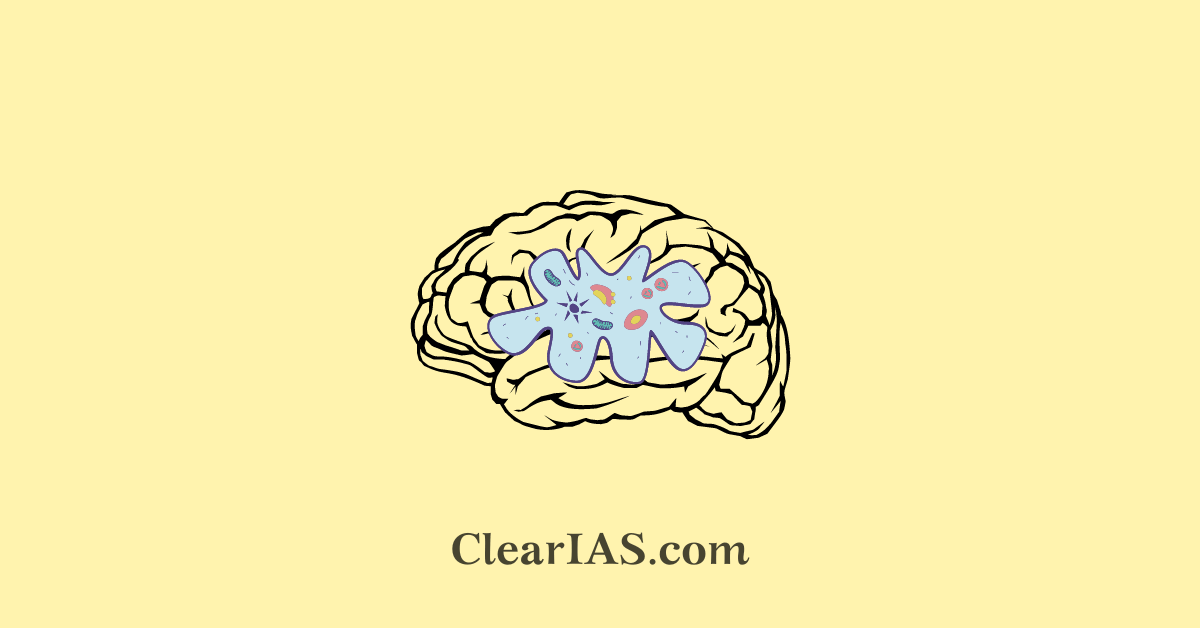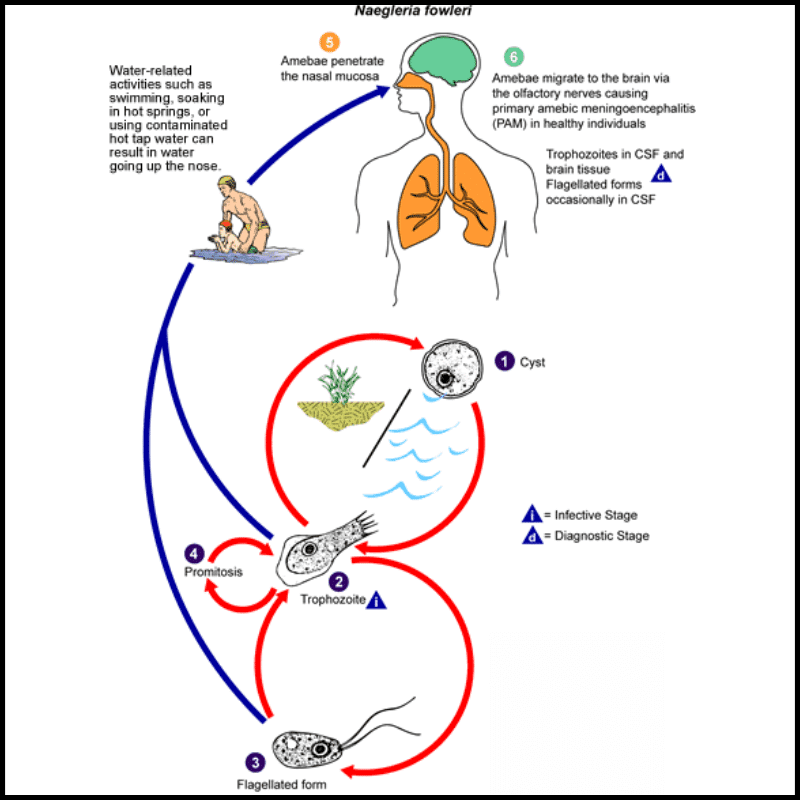
Due to several cases reported in Kerala, the brain-eating amoeba Naegleria fowleri is back in the spotlight. Read here to learn all about the rare but fatal infection.
Each year, sporadic cases are reported in hot and humid areas of the world, and they are frequently fatal.
Usually, these infections occur in people swimming in lakes, rivers, or underchlorinated pools, although clusters of infections have also been linked to contaminated water supplies.
For now, infection with N. fowleri (Naegleria) is rare, but scientists are concerned that climate change could cause this, and other pathogenic amoebas, to expand their ranges towards the poles, and bring more people into contact with infected water.
Brain-Eating Amoeba: Naegleria fowleri
Naegleria fowleri, commonly known as the brain-eating amoeba, is a free-living microscopic amoeba that can cause a rare and devastating brain infection called primary amoebic meningoencephalitis (PAM).
This infection is almost always fatal.
- Free-living amoebas are tiny single-celled organisms that mostly live in freshwater.
- Four main types can cause human disease, of which N. fowleri (Naegleria) and Acanthamoeba species are particularly problematic.
- They can enter the body through the nose and travel to the brain, where they start to destroy tissue and cause the brain to swell, triggering a condition called primary amoebic meningoencephalitis (PAM).
- Naegleria can also survive in soil by forming dormant ‘cysts’, and infections have been linked to the inhalation of contaminated dust.
- Historically, Naegleria infections have largely been restricted to warm countries, especially areas where average annual temperatures lie between 15°C and 18 °C.
Key Characteristics Brain-Eating Amoeba, Naegleria fowleri

- Habitat: Naegleria fowleri is typically found in warm freshwater environments, such as lakes, rivers, hot springs, and poorly maintained swimming pools.
- Infection Route: The amoeba enters the human body through the nose, usually when individuals swim or dive in contaminated water. It then travels to the brain, causing severe inflammation and destruction of brain tissue.
- Symptoms: Early symptoms of PAM start 1-9 days after infection and can include headache, fever, nausea, vomiting, and stiff neck. As the disease progresses, symptoms can include confusion, loss of balance, seizures, and hallucinations. The disease progresses rapidly, often leading to death within about five days.
- Diagnosis and Treatment: Diagnosis is challenging and often occurs after death. Treatment options are limited but may include antifungal drugs, such as amphotericin B, and other drugs like miltefosine. Early diagnosis and aggressive treatment are critical but often not sufficient to save the patient.
Prevention
Although amoebic meningoencephalitis is extremely rare, and the chances of catching it are unlikely, there are measures that people can take to reduce their risk.
- Avoidance of Warm Freshwater: Especially in warm seasons when the amoeba is more likely to thrive.
- Nasal Protection: Using nose clips or avoiding putting the head underwater in freshwater bodies can reduce the risk.
- Water Safety: Ensuring swimming pools and other recreational water venues are properly maintained and chlorinated.
Global Cases and Impact
Naegleria fowleri infections are rare. However, when they do occur, they predominantly happen in the United States but have also been reported in other countries, particularly those with warm climates.
- During 2024, unconnected infections have also been reported in Pakistan, Israel and Wyoming, US.
- Naegleria was also detected at a popular freshwater swimming spot in Western Australia earlier this year, prompting its closure.
- Local officials believe unusually high temperatures may have bolstered amoeba numbers.
- Infections are being reported in cooler areas, such as the northern US state of Minnesota.
- The amoeba was also recently detected at wastewater treatment plants in parts of the UK, although this was before the water had been treated.
Climate change may increase infections
Scientists are concerned that such infections could become more common because of climate change.
Naegleria thrives in warm waters and can tolerate temperatures of up to 46°C, making it well-suited to spread as countries grow hotter.
- Many countries are already recording extreme temperatures and many people are seeking relief from the heat by immersing themselves in water that is often very warm and polluted by coliforms (gut bacteria), perfect conditions for the growth of N. fowleri.
- People in some of the same areas practise cleansing rituals in which water is forced through the nasal passages by specialised neti pot devices or other means. This is believed to be the cause of the alarming increase in the incidence of PAM in cities such as Karachi.
- Extreme weather events such as droughts and flooding may also enhance its spread, by concentrating the amoeba in swimming spots and encouraging the use of roof-harvested rainwater systems or artesian wells during dry weather; and moving the amoeba to new areas during flood events.
In news
A 14-year-old boy from Kozhikode has recovered from primary amoebic meningoencephalitis (PAM), a rare and fatal infection with a mortality rate of 97%.
Health department sources claimed on July 22 2024 that it was rare in the country as very few people had survived the infection across the world.
Conclusion
Research is ongoing to better understand Naegleria fowleri and to develop more effective treatments and preventive measures.
The challenges include the amoeba’s rapid progression once inside the human body and the difficulty in diagnosing the infection early.
Frequently Asked Questions (FAQs)
Q. Where is the brain-eating amoeba found?
Ans: Historically, Naegleria infections have largely been restricted to warm countries, especially areas where average annual temperatures lie between 15°C and 18 °C.
Q. How to avoid brain-eating amoeba?
Ans: Don’t swim, wade or do watersports in warm freshwater locations, especially still waters, without nose plugs. Don’t go into the water at all if Naegleria fowleri is known to be present or likely to be present. Don’t use tap water for a neti pot or any other device that cleans your nasal passages.
Q. Can brain-eating amoeba be cured?
Ans: Primary amoebic meningoencephalitis caused by Naegleria fowleri is a rare but nearly always fatal parasitic infection of the brain. Globally, few survivors have been reported, and the disease has no specific treatment.
Q. What are the symptoms of a brain amoeba?
Ans: Early symptoms of PAM start 1-9 days after infection and can include headache, fever, nausea, vomiting, and stiff neck. As the disease progresses, symptoms can include confusion, loss of balance, seizures, and hallucinations. The disease progresses rapidly, often leading to death within about five days.
Related articles:
-Article by Swathi Satish






Leave a Reply